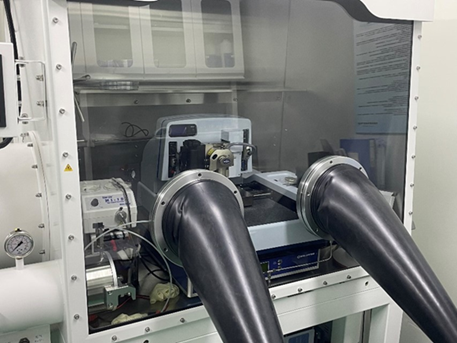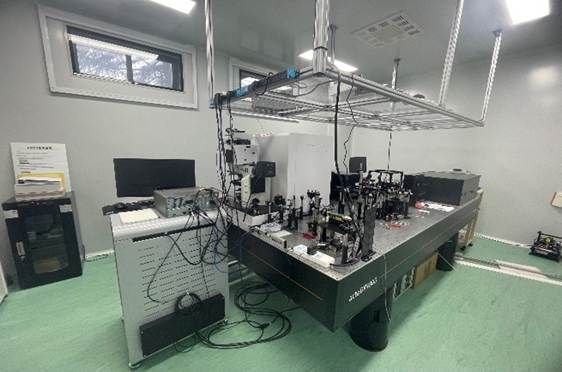
Room temperature atomic force microscope system protected by high purity nitrogen atmosphere
Model:Dimension Icon
Working Mode
Atomic force microscopy (AFM): observes the surface morphology, roughness and other microscopic structural information of two-dimensional materials, providing a basis for studying the physical and chemical properties of materials. Detects the mechanical properties of material surfaces and films, such as hardness and elasticity.
Kelvin probe force microscopy (KPFM) : A functional mode of AFM that can quantitatively measure the local surface potential distribution and obtain work function information. It can be used to characterize the potential distribution on the surface of the material, infer its band structure and defect distribution, and then understand the polarization state and domain distribution of ferroelectric materials.
Piezoelectric force microscopy (PFM) : used to characterize the piezoelectric, ferroelectric and other electromechanical coupling properties of materials. It can visualize the ferroelectric domains and domain walls in the material, and can also be used to study the polarization reversal of the domains, explore the dynamic processes of domain nucleation, phase structure stability, domain wall motion, and the interaction between domain structure and morphological defects in ferroelectric materials.
Magnetic force microscopy (MFM) : AFM-derived technique used to measure the magnetic properties of materials. Its probe is coated with a magnetic coating. It can detect magnetic properties such as the magnetic domain structure and magnetic anisotropy of the material. By measuring the magnetic force gradient, the magnetic domain distribution on the surface of the material can be displayed, providing important information for understanding the magnetic origin and magnetic domain dynamics of two-dimensional ferromagnetic materials.
Conductive Atomic Force Microscopy (CAFM) : CAFM can measure the local current-voltage characteristics of a sample and characterize the local conductivity of the surface. It can be used to detect the conductive properties of materials, analyze the charge transport characteristics in materials, and study the relationship between the electrical properties and microstructure of materials.
Lateral force microscopy (LFM) : Detects lateral forces through cantilever torsion, reflecting surface friction or chemical heterogeneity. It can be used to identify differences in friction characteristics in different areas of the material surface, thereby indirectly reflecting changes in the chemical composition and structure of the material.
In-situ ultra-low temperature micro-spectroscopy laboratory

Brillouin Light Scattering (BLS)
By utilizing inelastic light scattering and non-contact measurement of the tiny frequency shift (Brillouin frequency shift) produced by the interaction between the laser and the thermal phonons of the material, the phonons and magnons of the material can be inverted. This provides an irreplaceable tool for understanding the mechanical-magnetic coupling mechanism of the material, and has broad prospects in cutting-edge fields such as nanotechnology, quantum materials and biomechanics.
The grating spectrometer is used to measure Raman and PL simultaneously. In Raman testing, after the laser excites the sample, photons and molecular vibrations/lattice phonons are inelastically scattered, resulting in frequency shifts. The spectrometer separates the Raman scattered light and suppresses Rayleigh scattering. In PL testing, after the material absorbs photons, the electrons transition to the excited state and emit photons when returning to the ground state. The spectrometer provides a long-pass filter to filter out the laser excitation line to measure the PL of the material. The high-precision dispersion of the spectrometer realizes the "fingerprint recognition" of Raman and PL, becoming a "basic tool" in the fields of materials science, chemistry, and biomedicine, and is irreplaceable in nanotechnology and quantum material research.